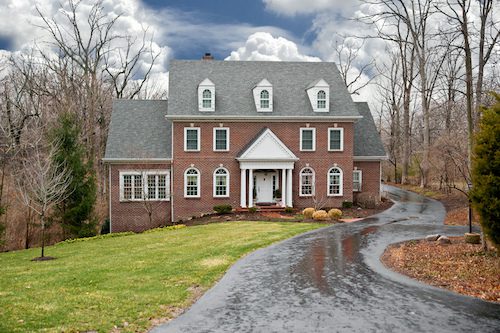If you live in an area with extreme weather conditions, you know how difficult it can be to protect your home against the elements. While concrete is a very stable material that can handle a lot of wear and tear, it can’t always withstand extreme challenges like intense temperature fluctuations, weak soil conditions, severe freeze-thaw cycles, or flooding. Let’s explore the challenges — and solutions! — for polyjacking in extreme conditions.
How Extreme Conditions Impact Concrete Integrity
In Kansas City, we’re well-versed in extreme weather and its (sometimes literal) impact on homes. Tumultuous storms can bring torrential downpours of rain that lead to flash floods, and if temperatures fluctuate enough this can create brutal freezing and thawing cycles on the soils beneath your concrete.
Here are a few of the most common issues you might encounter with your concrete driveway, sidewalk, or foundation as a result of living in extreme conditions:
Flooding and Water Damage
Water damage is a frightening phrase that homeowners prefer to avoid. Water getting into your home where it shouldn’t lead to mold and mildew growth that might result in significant demolition and repairs if left unchecked.
Flooding is an especially common weather-related condition in coastal areas, which is why you’ll commonly see houses built up on thick stilts along the Florida coastline. However, it can occur anywhere that gets heavy rainfall, including Kansas and Missouri!
Severe Freeze-Thaw Cycles
A freeze-thaw cycle refers to when temperatures fluctuate back and forth over the point at which water freezes (32°F/0°C). Temperatures drop below freezing at night, causing moisture in the ground to solidify and harden. As temperatures warm up during the day, this same moisture will thaw and loosen. Any moisture in the soil beneath your concrete will follow this cycle, expanding and contracting in a way that can eventually cause your concrete to crack or sink.
Unstable Soil and Other Geographical Challenges
While not weather-related, unstable soil is a geographical challenge that certainly qualifies as an extreme condition for concrete! If your home or other residential concrete is built on inherently unstable soils, like sand or other “Type C soil,” your concrete slabs are at a higher risk of sinking and cracking as the soil beneath them shifts and forms voids.
How Polyjacking Supports Concrete in Harsh Environments
While all of these extreme conditions are less than ideal for homeowners, they’re not without solutions! Polyjacking is the best form of concrete repair and leveling to support your home against all manner of extremes. Here’s how polyjacking partners with your concrete to bring your home permanent stability in any condition:
Whizbang Waterproofing
Water will inevitably soak into soil during storms (or even just when a sprinkler was left on overnight by mistake). What is not inevitable is that this moisture will harm your concrete!
Polyjacking is perfect for ensuring your concrete slabs and the soil beneath them remain in place despite extreme weather because the polyurethane foam used to support your concrete is waterproof! The foam creates a barrier against water damage by locking your concrete in place and preventing water from pooling underneath concrete slabs.
Foundational Fortification
If your concrete needs to be repaired or leveled as a result of freeze-thaw cycles or other water-related issues, weighing it down with a different but equally heavy cement mixture like mudjackers use will only exacerbate the problem over time. What you need is a concrete leveling solution that will both fortify your concrete and add very little extra weight to the slabs.
Polyurethane foam is practically weightless, and since it won’t absorb any water you can expect it to remain that way. What it lacks in weight it easily makes up for in strength, though, as this foam won’t let anything move out of position once it sets. You can rest assured your concrete isn’t going anywhere!
Stalwart Stability
Unstable soils may seem like a death sentence for concrete. After all, isn’t that why beach houses are often built up on stilts instead of flat on the sandy ground?
Actually, this is only partially true. While stilts are great for keeping a home up and away from water damage when built next to the ocean, they still need a stable foundation to keep everything in place. So before building a house on the sand, you need a strong concrete foundation. And this foundation must be able to hold its own despite unstable sands shifting underneath it. Enter: polyjacking!
Polyjacking can be used as a repair after concrete has shifted, but it can also be used to stabilize soils before a house is even built! Through a process called deep injection, your home can have all the stability it needs right from the start.
Your Weather May Be Extreme—But Your Solutions Don’t Have to Be!
Polyjacking isn’t invasive or complicated. It’s a quick and permanent solution that keeps your concrete strong no matter the conditions! If you’re worried about the impact Kansas City’s stormy season will have on your concrete, or if you’ve already begun to see signs of damage to your driveway or foundation, contact us at Pro Polyjacking for more information!
